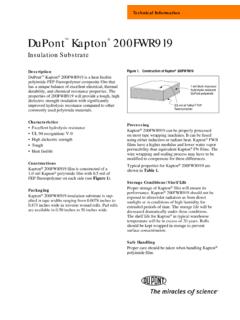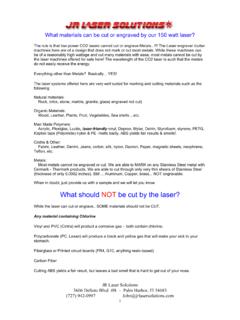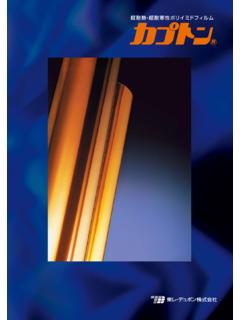Transcription of 4 Thermal Surface Finishes - matthewwturner.com
1 4 thermal surface finishes D. G. Gilmore,* W. K. Stuckey,* and M. Fong t Introduction Spacecraft Thermal designs employ wavelength-dependent Thermal -control coat- ings for various purposes. Solar reflectors, such as second- Surface mirrors, white paints, and silver- or aluminum-backed Teflon, are used to minimize absorbed solar energy, yet they emit energy almost as a blackbody would. To minimize both the absorbed solar energy and infrared (IR) emission, polished metal such as alu- minum foil or gold plating is used. Black paint is commonly utilized on the inte- rior of the vehicle, to facilitate radiant heat transfer among internal components.
2 Thus the existing state of the art includes a rather wide variety of wavelength- dependent coatings. The problems of in-space stability, outgassing, and mechani- cal adhesion to the substrate have all been resolved for most coatings. Many fully qualified coatings are available, so development and qualification of a new coating is normally unnecessary. The external surfaces of a spacecraft radiatively couple the spacecraft to space. Because these surfaces are also exposed to external sources of energy, such as sun- light and Earth-emitted IR, their radiative properties must be selected to achieve an energy balance at the desired temperature between spacecraft internal dissipa- tion, external sources of heat, and reradiation to space, as illustrated in Fig.
3 The two primary Surface properties of importance are the IR emittance and the solar absorptance. Figure indicates the range of properties available for differ- ent types of materials. Two or more coatings are sometimes combined in a check- erboard or stripe pattern to obtain the desired combination of average absorptance and emittance. Thermal -control surfaces fall into four basic categories: solar reflector, solar absorber, flat reflector, and flat absorber (see Fig. ). The solar reflector reflects incident solar energy while absorbing and emitting IR energy. Solar reflectors are characterized by a very low ct/e ratio. Solar absorbers absorb solar energy while emitting only a small percentage of the IR energy.
4 Flat reflectors reflect energy throughout the spectral range ( , in both the solar and IR regions), while flat absorbers absorb throughout the spectral range. Common Thermal Surface Finishes Almost all visible surfaces on the inside and outside of uncrewed spacecraft are Thermal -control Finishes ; this reflects the fact that all physical objects absorb and emit Thermal energy in the form of radiation. The flow of heat resulting from absorption and emission by these surfaces must be controlled in order to achieve a Thermal balance at the desired temperatures. The principal external Surface Finishes *The Aerospace Corporation, E1 Segundo, California.
5 TLockheed Martin Corporation, Sunnyvale, California. 139 140 Thermal Surface Finishes Surface finish determines ec, ~i!le/ Environmental heat loads r.,,int_~iiiir . ~ Aoo~o(solar + albedo) Aoeo(IR) I "'n'Jiil ~ Reradiatedenergy Aoeo~T 4 Environmental loads +T_,Qin t = Reradiated energy (Steady state) Fig. Radiator energy balance (no external blockage). seen on most spacecraft are the outer layer of insulation blankets, radiator coat- ings, and paints. Electronics boxes located inside the spacecraft, and the structural panels to which they are attached, are usually painted to achieve a high emittance. (While most paints have the required high emittance regardless of color, black paints have been the conventional choice for internal applications.)
6 Internal tem- perature-sensitive components that do not dissipate much heat, such as propellant lines or tanks, often have a low-emittance finish of aluminum or gold. Common Thermal Finishes and their optical properties are shown in Table The outer-cover layer of insulation blankets is usually made of aluminized Kap- ton, black Kapton, or Beta cloth. Aluminized Kapton is a gold-colored material that has a moderate solar absorptance, a high IR emittance, and a typical thickness of 1 to 3 mils. Black Kapton has a high solar absorptance because it is loaded with carbon to improve electrical conductivity for blanket-grounding purposes.
7 Beta cloth is a very tough Teflon-coated glass fabric that has a low solar absorptance and high emittance. As will be discussed in Chapter 5, the choice of which mate- rial to use as the outer-cover layer of the blanket is driven by design requirements such as Thermal optical properties, glint prevention, electrical grounding, stress handling, and micrometeoroid protection. Radiator coatings are typically second- Surface mirrors or white paint. The prin- ciple behind the second- Surface mirror (illustrated in Fig. ) is the use of a visi- bly transparent material, such as quartz glass or Teflon, to achieve a high emit- tance, along with a reflective silver or aluminum coating on the back to minimize Common Thermal Surface Finishes 141 v (1) tj c- t1:l '-- 0 c~ L_ 0 O9 1 / I I 0 ' I ' I I Emittance (e) I Black paints I I _ I Selective blacks (solar absorbers) I~ Sandblasted metals and conversion coatings White paints and second- Surface mirrors 1~1 Bulk metals (unpolished) ~'~ Dielectric films on polished metals Fig.
8 Surface properties by type of finish. solar absorptance. Quartz second- Surface mirrors, often referred to as optical solar reflectors (OSRs), typically come in small tiles with dimensions on the order of a few cm and a thickness of up to mm (10 mils). These tiles are bonded to the radiator Surface with acrylic or silicone adhesives. (When bonding to a metal sub- strate, acrylic adhesive should not be used below -45 C because the mirrors may crack or delaminate.) Teflon second- Surface mirror material, sometimes referred to as flexible OSR, comes in a variety of thicknesses (and therefore emittances) and is usually supplied as a tape or sheet with an acrylic adhesive backing for ease of installation.
9 Standard quartz and Teflon OSRs are highly specular, but they also come in a diffuse variety that has a somewhat higher absorptance. While space-qualified paints are available in a variety of colors, black and white are by far the most commonly used. Almost all paints have a high emittance, so the choice is really between solar absorptance (and its degradation in the space environment), ease of application, and electrical conductivity to meet grounding requirements. Most internal spacecraft surfaces are painted black for high emit- tance, while exterior surfaces , including radiators, are often painted white to mini- mize absorbed solar energy.
10 In choosing a white paint, one must consider that some paints will experience a greater increase in absorptivity than others as a result 142 Thermal Surface Finishes m Solar absorber o 1 Ideal I 0 e~ r' .. ~ / Polished ~ I '~--~Z aluminum alloy o I ~ "- i o3 2 10 20 Wavelength (Ixm) m Flat absorber o 1 ..I __J-- = ,.- Ideal O Black paint o I 1 co 2 10 20 Wavelength (gm) Solar reflector [,.~ ,.. L .. _ % -~k~ldea I - I~ t" --Whitepaint IJ, 0 2 10 20 Wavelength (lxm) Flat reflector 1 I I Ideal /_ /Aluminum _ _ 2/_ paint _- ;_- .. 01 i 2 10 20 Wavelength (lam) Fig. Ideal representation of four basic passive-control surfaces .]









